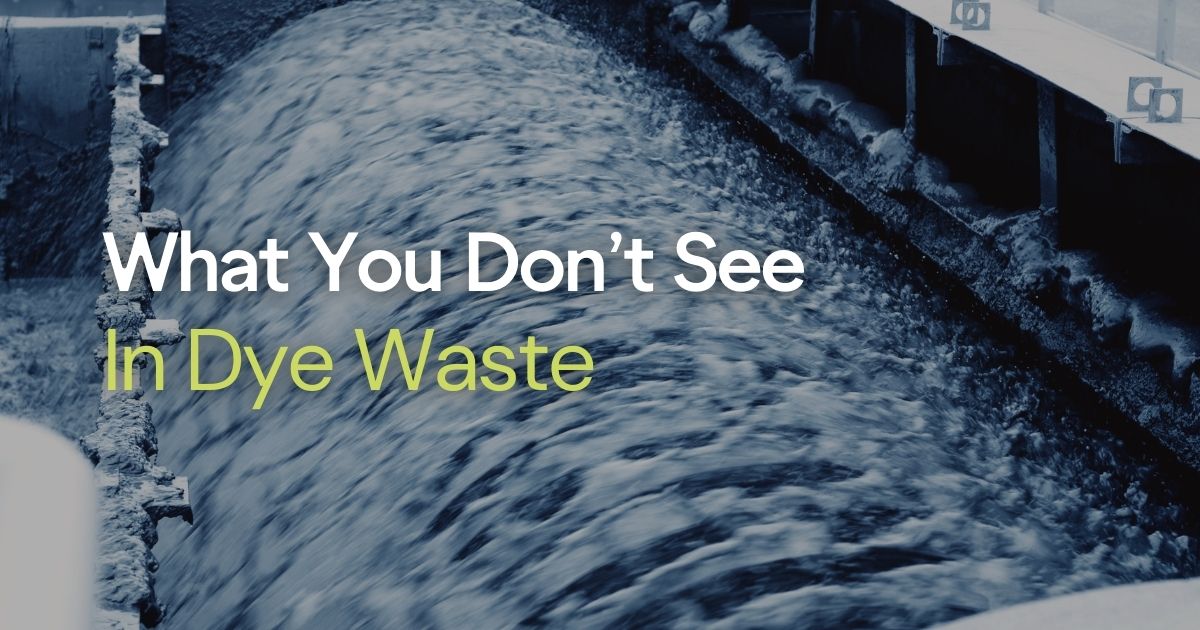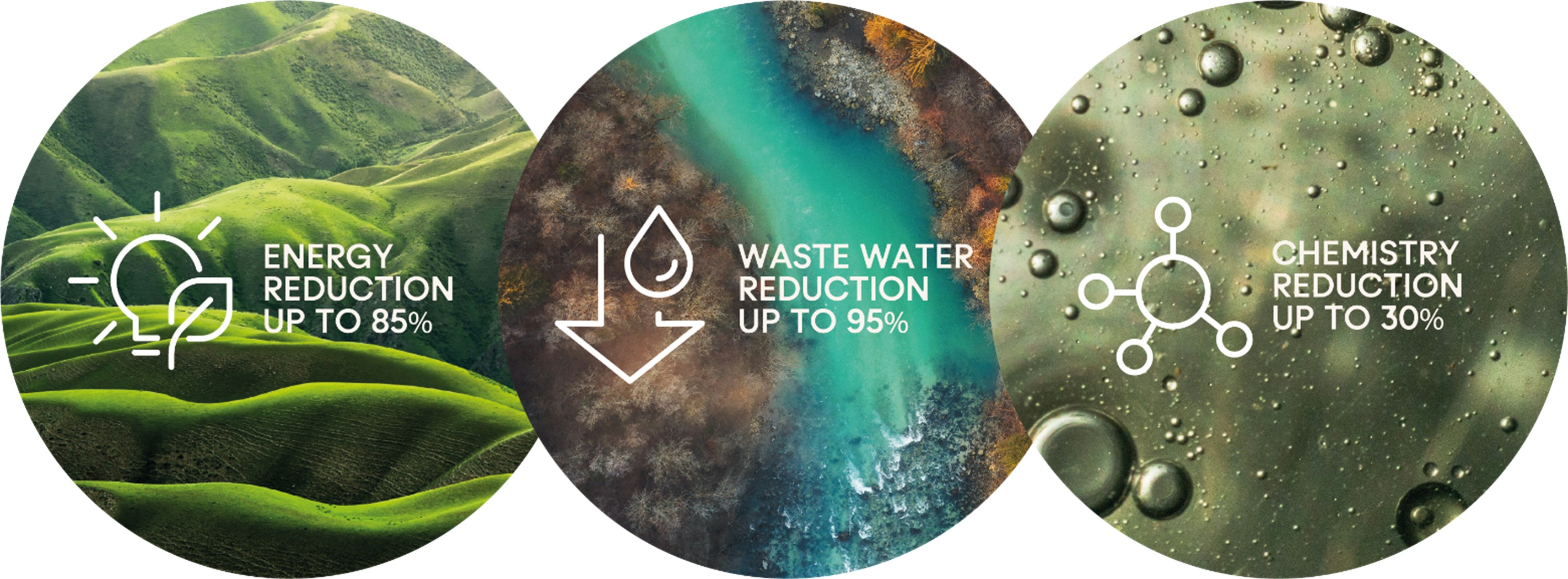
Every day, billions of litres of water are used in textile dyeing. Discharged into waterways and carrying with them a cocktail of chemicals invisible to the naked eye. From the outside, it may look like just another stream of excess water. However, it’s what you don’t see in dye waste that raises the real questions.
Get to know Dye Waste
Dye waste is the contaminated liquid, alternatively known as wastewater, produced from dyeing textiles. Often containing unfixed dyes, chemicals, and residual pollutants from traditional textile dyeing methods. Dye waste is particularly difficult to treat because the dyes are often persistent and resistant to biodegradation. Posing significant environmental hazards to rivers, lakes, and local ecosystems.
What you don’t see in dye waste is the chemicals in the wastewater. Such chemicals include during the pre-treatment and bleaching stage, unfixed reactive and disperse dyes, salts and pH adjusters, among others. During pre-treatment and bleaching, hydrogen peroxide and sodium dithionite are used to make fabrics uniformly white before dyeing. While enzymes such as amylase protect warp threads during weaving and ensure the fabric is absorbent and clean for dyeing.
As for dyeing, reactive and disperse dyes both contain azo and anthraquinone. These chemicals support the dyeing of various vivid colours, ensuring versatility in textile production. Within the dye solution, salts and pH adjusters are added. Electrolytes such as sodium chloride and sodium sulphate are added to support dye fixation and create ionic strength.
Although textiles is one of the main sources of dye waste, it also comes from other industries. Colouring paper and plastics for the packaging industry, for example, and the pharmaceuticals industry using dyes as excipients, coatings, and markers in medicines (Singh, P., 2024).
The Hidden Costs of Textile Dyeing
Traditional dyeing remains one of the most resource-intensive stages in the textile supply chain. To dye a single kilogram of fabric can consume up to 150 litres of water during dyeing, much of which is contaminated with invisible pollutants you don’t see in dye waste. Multiply this by the millions of tons of textiles produced each year, and the hidden costs of textile dyeing are staggering.
What remains behind in this wastewater isn’t just colour. It’s residual chemistry that is produced as a by-product of textile dyeing that can persist in ecosystems for decades. Once released into rivers, these substances disrupt aquatic life, seep into agricultural soils, and affect the health of communities living downstream.
The most alarming part? Most of this damage is invisible. Unlike a visibly polluted river, dye waste can look deceptively clean but still carries a toxic burden.
The Challenge of Dyeing Sustainably
The scale of this problem demonstrates that the industry must face one of its greatest challenges of dyeing sustainably. According to estimates, textile dyeing accounts for up to 20% of global industrial water pollution. In regions where dyehouses operate without proper treatment facilities, rivers often run red, blue, or black depending on what colour is the seasonal trend.
Beyond pollution, the sheer volume of water required is unsustainable. With global freshwater supplies under pressure from climate change and an increasing global population, continuing with water-intensive dyeing processes is simply not viable. Posing a critical question, how can the industry continue to meet demand while reducing its environmental impact?
For the industry to move on, and for textile dyeing to shift towards true sustainability, it must embrace alternatives that dramatically cut water use and eliminate toxic runoff. Innovative technologies are revolutionising how fabrics are dyed, making it possible to achieve the same, if not better, quality with a fraction of the environmental cost. From biodegradable dyes to near-waterless dyeing machinery. Therefore, clean-tech innovations are a step change from traditional textile dyeing, capable of achieving high performance, sustainably dyed textiles while eliminating what you don’t see in dye waste.
Eliminating Dye Waste
Among these clean-tech innovations, our Endeavour™ digital textile dyeing solution stands out. Instead of flooding fabrics in vats of dye, Endeavour™ uses piezoceramic nozzles that deliver ultra-precise 10-micron droplets, with every nozzle digitally controlled to apply exactly the right amount of colour. This precision means the technology uses the minimum dye required to achieve consistent, high-quality results, virtually eliminating excess chemicals and dramatically reducing waste. The outcome: vibrant textiles with significantly lower environmental impact.
Read more about wastewater here.
A Future Without Dye Waste
We at Alchemie Technology combine clean-tech innovation with scalable solutions for the textile dyeing industry.
Our Endeavour™ system is a full-scale production solution that takes digital textile dyeing onto the factory floor. Endeavour™ delivers vibrant, high-quality fabric colouration with using up to 95% less water, up to 85% less energy, and up to 30% less chemistry, compared to traditional textile dyeing methods. Proving that sustainability and efficiency can go hand-in-hand at industrial scale. Eliminating dye waste, conserving resources, and setting new standards for clean-tech in textiles.
Endeavour™ represents a blueprint for a future without dye waste.
 Today, with the various clean-tech solutions available, dye waste from traditional textile dyeing methods can be eliminated. Providing forward-thinking brands and dyehouses are willing to change.
Today, with the various clean-tech solutions available, dye waste from traditional textile dyeing methods can be eliminated. Providing forward-thinking brands and dyehouses are willing to change.
With digital textile dyeing solutions like Endeavour™, the industry can move toward a future where what you don’t see in dye waste is drastically reduced. By minimising chemical discharge and water use, this technology helps prevent further pollution of waterways worldwide. Sustainable textile dyeing is no longer just a vision; it’s an achievable reality.
Contact us at enquiries@alchemietechnology.com.